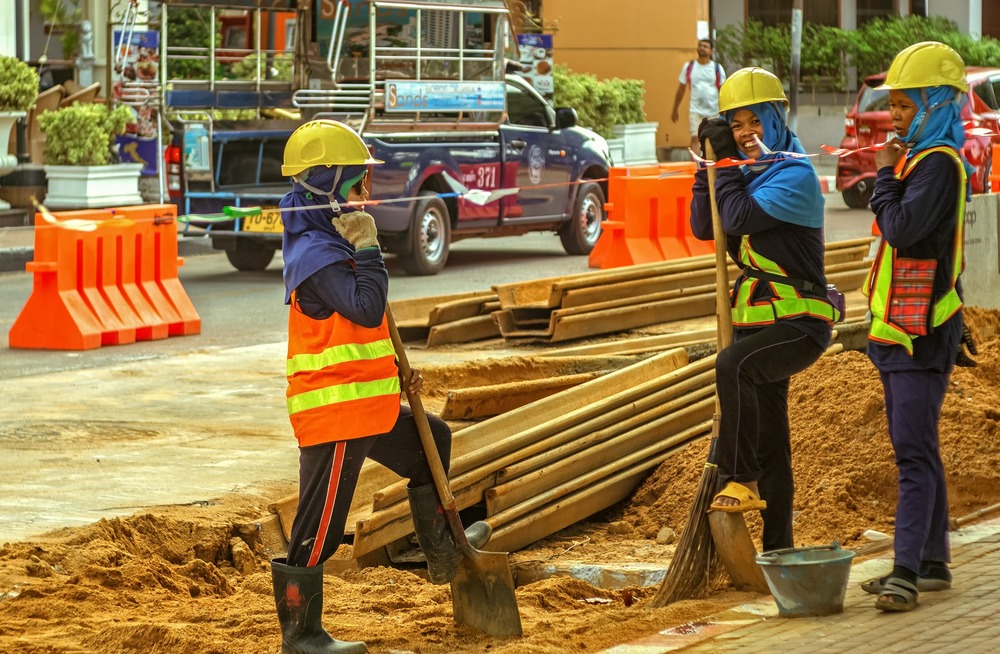This article is part of a blog series on the risk of labor shortages in the construction industry, exploring how women can be the solution.
Being a woman in the construction industry is full of challenges:
- hostile surroundings
- sexual and physical harassment
- sexist remarks
- demeaning criticism
- isolation.
Construction is probably one of the most male-dominated industries. So getting deference from male colleagues continues to be an issue for women.
As described in our previous post, women represent only 10.9% of the construction workforce and even less on construction sites and the trade. This makes it 1.25% of the total women workforce in the USA. Plenty of opportunities for the construction industry to tap into the 98.75% of women working outside the industry.
The industry has to find a way to close the gender gap to surmount the labor shortage crisis. A few solutions could be:
- suppressing the unconscious gender bias
- providing more suitable training
- overcoming the poor perceptions of women working in construction.
The number of women working in the industry is increasing. For example, a Randstad survey found that in the United Kingdom women in construction management roles increased by 9% from 2018 to 2020. Women bring a wide range of skills that profit organizations in the construction industry.
The History of Women in Construction

Education for common women became mandatory when:
- in 1870 all children between 5 and 12 were supposed to attend schooling in the United Kingdom
- in 1852 Massachusetts passed the first compulsory school laws
- in 1853 New York followed
- in 1918 all American children were required to attend at least elementary school.
Until then, only philanthropists like Angela Burdett-Coutts (1814-1906), supported poor children's education by building hundreds of schools.
Girls at the time were not felt suitable for education or physical activities. Only in 1850 an educationalist Frances Mary Buss (1827–1894) opened a secondary school for girls in London.
It took even longer for women to be able to attend university. Emily Davies (1830-1921) and Barbara Bodichon (1827–1891) pushed for women to be able to sit exams and gain degrees, they started a residential college for women at Cambridge University in the second half of the 19th century. In England, women were fully admitted to universities in 1948.
During the middle-age, women were working in the construction industry:
Women started working in the construction industry in Spain as early as the 13th Century.
At the time, women in Navarre were working as day laborers on wood and stone structures in the city.
From the 13th to 17th centuries, you could find skilled female construction laborers and tradespeople in France, England, and Germany despite the fact that women workers were considered socially unacceptable as they were considered physically unfit to carry heavy labor, so employing them in construction was considered immoral.
The only records we have of female laborers are anonymous.
Historians found out that poor women employed as construction day laborers were a common practice in the past. They:
- carried water
- thatched roofs
- ditched foundation for walls.
Women in building trades were typically middle-class. They usually gained experience of carpentry, masonry or similar techniques from their dads or husbands.
In the economic crises leading up to the industrial revolution in Europe, men were prioritized over women who were restricted from participating in the trade guilds, and the daughters and wives who were previously involved in the family business were dismissed.
Women in construction during the industrial revolution
As the industrial revolution expanded the labor market, women were invited back to construction sites, as tradespeople and laborers, and were no longer socially censured to work in the industry.
The situation changed when the troops returned, and women were fired from the jobs they held.
Dissatisfied with the overall injustice, women eventually started the feminist movement of the 1960s, fighting for equal rights.
Pioneering females in construction
Lady Anne Clifford
The first woman recorded in British history to lead building projects was Lady Anne Clifford. She:
- erected in 1656 Countess Pillar near Brougham, Cumbria, in memory of her late mother
- restored churches at Appleby-in-Westmorland, Ninekirks, Brougham, and Mallerstang
- improved and expanded many of the Clifford family's castles across Northern England.
Lady Elizabeth Wilbraham
Elizabeth was the first woman architect. She
- drew up her own designs
- designed grand houses for her family
- was involved in up to 400 other buildings
- employed male architects to carry out her plans for her. 18 churches in London were attributed to Christopher Wren who probably was one of the male architects she used.
Ethel Charles
Ethel got admitted into the Royal Institute of British Architects (RIBA), becoming the first woman to be accepted to the faculty in 1902.
- She was not given any commissions for big projects as they could only be controlled by men
- She worked on improving laborer’s cottages
- She is now regarded as having significantly developed the old English style towards the garden city movement, a method of urban planning that surrounded communities with greenbelt land
- Her sister Bessie, was the second female member of RIBA and worked with Ethel all her professional life
Emily Warren Roebling
Emily was one of the first woman engineers who directed the construction of the famous Brooklyn Bridge after her husband Washington Roebling got ill.
She was key to the project’s success, and as a gesture of appreciation, President Chester A. Arthur invited her to cross the full bridge’s length in 1883, when the bridge was officially opened.
Julia Morgan
Julia was the first to be admitted to one of the most prestigious architecture schools, École Nationale Supérieure des Beaux-Arts, in Paris and the first to become a licensed woman architect in California.
Men are behaving better toward women in construction

The labor shortage worldwide means more jobs for women.
In 2022, industry leaders believe things are changing when it comes to gender and jobs.
Some women are still frustrated by men’s mentality
A majority of females are still experiencing, in their jobs:
- discrimination
- harassment
- improper remarks.
The mentality of older males, unfortunately, is very hard to change, making it difficult for young women to be properly considered despite their good performance.
An office administrator for a General Contractor in North Carolina said:
There is the old-school mentality of some of our older subcontractors. Sometimes there are comments made about women or LGBTQ+ people that make me uncomfortable.
It is not all women that complain about this attitude. Many women prefer working in construction because of that aspect.
An accountant for a subcontractor in South Carolina said:
Women are multitasking oriented and men appreciate when I juggle a lot of tasks at once.
Women are needed in the construction industry

Experts predict that women could soon represent half of the newly recruited employees in every role:
- designers
- architects
- engineers
- construction workers, etc.
Some promising news
According to a Smart Asset Study, the number of women holding jobs in construction is growing (the statistics pre-date the COVID-19 pandemic, so it could change). Other findings:
- The construction industry is serving high salaries: $156,000 for the high end of construction manager, $68,000 for laborers and painters,
- The industry is one of the most gender-equality-supporting industries in terms of salary. Women earn about 95% of what their male counterpart earn.
- The US bureau of labor statistics says that construction employment had a strong bounce back after the COVID lockdowns and other restrictions. It started in the late spring of 2020 and has grown continuously since then. Employment in the industry passed pre-pandemic levels in January 2022.
- Soon, women should represent 50% of the newly hired people in the industry.
Some adverse trends
- Construction employment in the USA is projected to only grow 2.8% between now and 2031, compared to an average 5.3% rate of job growth across all industries.
- Technological changes in the industry will automate processes so productivity will increase, and the need for laborers will decrease.
- Demand in industries depending on construction projects, like energy, may create jobs in some areas while reducing employment in others.
Challenges to overcome before attracting women into construction
Safety
The construction industry is a dangerous place for all employees, but more unsafe for women. As the shape of safety equipment is not fit for women.
Solution: To employ women, companies should provide the correct PPE.
Patterns
Most people think that construction jobs require you to be in the field for the project’s success. This is a myth. Women will not have to go to the construction sites if:
- they work as architects, designers, construction managers, etc.
- they use technology to reduce their journeys to the field.
Solution: break the pattern by changing women's perception of the wide range of skills and experience required to work in construction companies.
Discrimination
The industry is male-dominated and a lot of older males are working there. Women may feel intimidated to work on construction sites dominated by that demographic. A Royal Institution of Chartered Surveyors survey found that one-third of women interested in entering the construction industry did not do it for fear of sexism.
Solution: harassment should be punishable on the construction site irrespective of gender, sexual orientation, or ethnicity.
Issues are discounted
Ignoring the issues revealed in a study done by the Construction Industry Federation would prevent women from embracing careers in the construction industry. Here are their findings:
- 65% of companies fail to attract qualified female graduates
- 59% of companies have difficulties in hiring skilled female workers outside of the sector
- 60% failed to provide a flexible working environment for women
- 52% admit they do not like assisting women who have taken a career break and want to return to work
- Only 30% believe that their company has to improve the gender balance.
Solution: Construction companies should realize that they have to change if they want to hire more women.
In Conclusion

The construction industry still has to make women's life easier, so they can perform better, and take a bigger share of the workforce.
The future for women seems to be brilliant and will help reduce the labor shortage crisis the industry is facing. Companies in construction are already taking steps towards improving gender equality in their workforce. A trend implies that in the next 10 years, there will be more women-owned construction companies.
Now is the time for women to enter the construction industry but the companies employing them still have a lot of work to do to attract them!
Driving Vision's organization diagnostic looks at the best way to evaluate which skills you have and if there are gaps to be filled either internally or externally.
The organization report is central to a successful operation, in line with the type of projects you produce and your client’s organization.
A Driving Vision expert will conduct the interviews online and will issue a report and discuss our findings with you.
Together we will decide the best way to implement the solutions at your pace and according to your budget.
Implementing BIM can be daunting, but Driving Vision is here to help you at the pace you are comfortable with. Get started by getting in touch now






